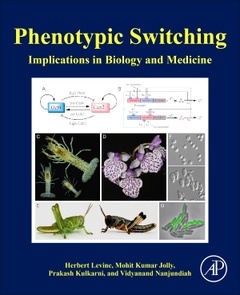Phenotypic Switching Implications in Biology and Medicine
Coordonnateurs : Levine Herbert, Jolly Mohit Kumar, Kulkarni Prakash, Nanjundiah Vidyanand

Phenotypic Switching: Implications in Biology and Medicine provides a comprehensive examination of phenotypic switching across biological systems, including underlying mechanisms, evolutionary significance, and its role in biomedical science. Contributions from international leaders discuss conceptual and theoretical aspects of phenotypic plasticity, its influence over biological development, differentiation, biodiversity, and potential applications in cancer therapy, regenerative medicine and stem cell therapy, among other treatments. Chapters discuss fundamental mechanisms of phenotypic switching, including transition states, cell fate decisions, epigenetic factors, stochasticity, protein-based inheritance, specific areas of human development and disease relevance, phenotypic plasticity in melanoma, prostate cancer, breast cancer, non-genetic heterogeneity in cancer, hepatitis C, and more.
This book is essential for active researchers, basic and translational scientists, clinicians, postgraduates and students in genetics, human genomics, pathology, bioinformatics, developmental biology, evolutionary biology and adaptive opportunities in yeast.
1. The fundamentals of phenotypic plasticity
2. Rethinking the role of chance in the explanation of cell differentiation
3. Random walk across the epigenetic landscape
4. Maneuvering protein functions and functional levels by structural excursions
5. Prion-mediated phenotypic diversity in fungi
6. Bistability in virus - host interaction networks underlies the succes of hepatitis C treatments
7. Quantifyinh Waddington landscapes, paths, and kinetics of cell fate decision making of differentiation/development
8. The physics of cell fate
9. Disentangling the environmentally induced and stochastic development components of phenotypic variation
10. The evolution of cell differentiation in animals: biomolecular condensates as amplification hubs of inherent cell functions
11. Phenotypic switching and its evolutionary consequences
12. Cell-state organization by exploratory sloppy dynamics
13. Emergence of metabolic heterogeneity in cell populations: lessons from budding yeast
14. Stochastic phenotypic switching in endothelial cell heterogeneity
15. Regulation of phenotypic plasticity from the perspective of evolutionary developmental biology
16. Phenotypic plasticity and the origins of novelty
17. Niche construction and the transition to herbivory: Phenotype switching and the organization of new nutritional modes
18. NAture, nurture, and noise in bird song ontogeny as determinants of phenotypic and functional variation among dialects
19. Domestication as a process generating phenotypic diversity
20. The glycobiology of ovarian cnacer progression: phenotypic switches an microenvironmental influences
21.Epithelia-mesenchymal transition in cancer
22. Phenotypic switching and prostate diseases: a model proposing a causal link benign prostatic hyperplasia and prostate cancer
23. Phenotypic plasticty and lineage switching in prostate cancer
24. Implications of non-genetic heterogeneity in cancer drug resistance and malignant progression
25. Phenotypic plasticity: the emergence of cancer stem cells and collective cell migration
26. Adaptive phenotypic switching in breast cancer in response to matric deprivation
27. Phenotypic instability induced by tissue disuption at the origin of cancer
28. Evolutionary strategies to overcome cancer cell resistance ot treatment
Dr. Mohit Kumar Jolly obtained his B.Tech. and M. Tech. in Biological Sciences and Bioengineering at IIT Kanpur, India, and his Ph.D. in Bioengineering from Rice University, working at the interface of systems biology and cancer biology. After a short stint as independent postdoctoral fellowship in Computational Cancer Biology, he joined the Centre for BioSystems Science and Engineering at Indian Institute of Science (IISc) Bangalore, as an Assistant Professor. His work focuses on integrating mechanism-based mathematical models with experiments and clinical data to elucidate the mechanisms of cancer metastasis and therapy resistance. He won the 2016 iBiology Young Scientist Seminar Series – a coveted award for communicating one’s research to diverse audience.
Dr. Prakash Kulkarni is a Research Professor at the City of Hope National Medical Centre. After receiving his PhD in biochemistry from India,
- Thoroughly addresses the conceptual, experimental and translational aspects that underlie phenotypic plasticity
- Emphasizes quantitative approaches, nonlinear dynamics, mechanistic insights and key methodologies to advance phenotypic plasticity studies
- Features a diverse range of chapter contributions from international leaders in the field
Date de parution : 06-2020
Ouvrage de 762 p.
19x23.3 cm
Mots-clés :
?AMPK; Abnormal attractors; Adaptation; Anchorage independence; Androgen receptor; Anoikis; Anoikis resistance; Avian vocal dialects; Behavior; Benign prostatic hyperplasia; Bet hedging; Bet-hedging; Biological noise; Biological switch; Biomolecular condensates; Bird song learning; Bistability; Cancer; Cancer stem cell; Cancer stem cells; Cell differentiation; Cell fate; Cell-state organization; Cell–cell interaction; Chance; Chemoresistance; Curl flux; Darwin; Dedifferentiation; Deterministic model; Development; Developmental noise; Developmental plasticity; Developmental rates; Direct-acting antivirals; Diversity; Division of labor; Domain–domain interactions; Domestication; Domestication syndrome; Drug-sensitive cells; ECM; EMT; Eco-devo; Eco-evo-devo; Endothelial heterogeneity; Enhancers; Environmental adaptation; Environmentally induced variation; Enzalutamide; Epigenetic inheritance; Epigenetic landscape; Epigenetic memory; Epigenetic switch; Epigenetics; Epithelial-mesenchymal transition; Evolution; Explanation; Extended evolutionary synthesis; Foxes; Fungi; Gene expression; Genetic accommodation; Genetic assimilation; Genome; Genomes; Glycobiology; Grainyhead-like; Hepatitis C virus infection; Herbivory; Holobiont; Hormone receptor; Hybrid epithelial/mesenchymal phenotype; Inherency; Inheritance; Integrators; Interferon; Intrinsic protein disorder; Isogenic populations; Lineage plasticity; Macroevolution; Mathematical models; Matrix deprivation; Maximum tolerated dose; Metabolic states; Metabolism; Metastasis; Microbial communities; Modular dynamics; Modulation of functions; Moonlighting proteins; Mosaic heterogeneity; Multicellularity; Multiscale models; Neural crest; Neuroendocrine prostate cancer; Niche construction; Noise; Noise in gene expression; Nongenetic heterogeneity



